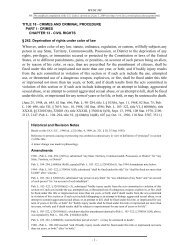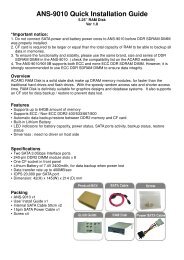2004 Instructions for Form 1040 (ALL) - Supreme Law Firm
2004 Instructions for Form 1040 (ALL) - Supreme Law Firm
2004 Instructions for Form 1040 (ALL) - Supreme Law Firm
Create successful ePaper yourself
Turn your PDF publications into a flip-book with our unique Google optimized e-Paper software.
Department of the Treasury<br />
Internal Revenue Service<br />
<strong>2004</strong> <strong>Instructions</strong> <strong>for</strong> Schedule E (<strong>Form</strong> <strong>1040</strong>)<br />
Use Schedule E (<strong>Form</strong> <strong>1040</strong>) to report income or loss from rental real estate, royalties,<br />
Supplemental partnerships, S corporations, estates, trusts, and residual interests in REMICs.<br />
You can attach your own schedule(s) to report income or loss from any of these sources.<br />
Income and<br />
Use the same <strong>for</strong>mat as on Schedule E.<br />
Enter separately on Schedule E the total income and the total loss <strong>for</strong> each part. Enclose<br />
loss figures in (parentheses).<br />
Loss<br />
Section references are to the Internal Revenue Code.<br />
Qualified nonrecourse financing is financing<br />
<strong>for</strong> which no one is personally liable <strong>for</strong><br />
it is a trade or business activity, and if so,<br />
whether you materially participated in the<br />
General <strong>Instructions</strong><br />
repayment and is: activity <strong>for</strong> the tax year.<br />
At-Risk Rules • Borrowed by you in connection with See the <strong>Instructions</strong> <strong>for</strong> <strong>Form</strong> 8582 to<br />
Generally, you must complete <strong>Form</strong> 6198 holding real property,<br />
determine whether you materially particito<br />
figure your allowable loss if you have: • Not convertible from a debt obligation pated in the activity and <strong>for</strong> the definition<br />
• A loss from an activity carried on as a to an ownership interest, and<br />
of “rental activity.”<br />
trade or business or <strong>for</strong> the production of • Loaned or guaranteed by any federal,<br />
See Pub. 925 <strong>for</strong> special rules that apply<br />
income, and<br />
state, or local government, or borrowed by<br />
to rentals of:<br />
• Amounts in the activity <strong>for</strong> which you you from a qualified person.<br />
• Substantially nondepreciable propare<br />
not at risk. Qualified person. A qualified person is a erty,<br />
The at-risk rules generally limit the person who actively and regularly engages • Property incidental to development<br />
amount of loss (including loss on the dispo- in the business of lending money, such as a activities, and<br />
sition of assets) you can claim to the bank or savings and loan association. A<br />
qualified person cannot be:<br />
• Property to activities in which you<br />
amount you could actually lose in the activ-<br />
materially participate.<br />
ity. However, the at-risk rules do not apply • Related to you (unless the nonre-<br />
to losses from an activity of holding real course financing obtained is commercially Activities That Are Not Passive<br />
property, if you acquired your interest in reasonable and on the same terms as loans Activities<br />
the activity be<strong>for</strong>e 1987 and the property involving unrelated persons),<br />
Activities of real estate professionals. If<br />
was placed in service be<strong>for</strong>e 1987. The ac- • The seller of the property (or a person you were a real estate professional in <strong>2004</strong>,<br />
tivity of holding mineral property does not related to the seller), or any rental real estate activity in which you<br />
qualify <strong>for</strong> this exception. • A person who receives a fee due to materially participated is not a passive acyour<br />
investment in real property (or a per- tivity. You were a real estate professional<br />
In most cases, you are not at risk <strong>for</strong><br />
amounts such as the following.<br />
son related to that person).<br />
only if you met both of the following con-<br />
• Nonrecourse loans used to finance the<br />
ditions.<br />
activity, to acquire property used in the ac-<br />
Passive Activity Loss Rules<br />
1. More than half of the personal servtivity,<br />
or to acquire your interest in the ac- The passive activity loss rules may limit the ices you per<strong>for</strong>med in trades or businesses<br />
tivity that are not secured by your own amount of losses you can deduct. These were per<strong>for</strong>med in real property trades or<br />
property (other than property used in the rules apply to losses in Parts I, II, and III, businesses in which you materially particiand<br />
line 40 of Schedule E.<br />
pated.<br />
activity). However, there is an exception<br />
<strong>for</strong> certain nonrecourse financing borrowed Losses from passive activities may be 2. You per<strong>for</strong>med more than 750 hours<br />
by you in connection with holding real subject first to the at-risk rules. Losses de- of services in real property trades or busiproperty.<br />
See Qualified nonrecourse fi- ductible under the at-risk rules are then nesses in which you materially particinancing<br />
below. subject to the passive activity loss rules. pated.<br />
• Cash, property, or borrowed amounts<br />
used in the activity (or contributed to the<br />
You generally can deduct losses from<br />
passive activities only to the extent of inactivity,<br />
or used to acquire your interest in<br />
For purposes of this rule, each interest in<br />
come from passive activities. An exception rental real estate is a separate activity, un-<br />
the activity) that are protected against loss<br />
applies to certain rental real estate activities less you elect to treat all your interests in<br />
by a guarantee, stop-loss agreement, or<br />
(explained on page E-2).<br />
rental real estate as one activity. To make<br />
other similar arrangement (excluding casu-<br />
this election, attach a statement to your<br />
alty insurance and insurance against tort Passive Activity original tax return that declares you are a<br />
liability).<br />
A passive activity is any business activity qualifying taxpayer <strong>for</strong> the year and you are<br />
• Amounts borrowed <strong>for</strong> use in the ac- in which you did not materially participate making the election under section<br />
tivity from a person who has an interest in and any rental activity, except as explained 469(c)(7)(A). The election applies <strong>for</strong> the<br />
the activity (other than as a creditor) or who on this page and page E-2. If you are a year made and all later years in which you<br />
is related, under section 465(b)(3), to a per- limited partner, you generally are not are a real estate professional. You can re-<br />
son (other than you) having such an inter- treated as having materially participated in voke the election only if your facts and<br />
est.<br />
the partnership’s activities <strong>for</strong> the year. circumstances materially change.<br />
Qualified nonrecourse financing. Quali- The rental of real or personal property is If you are married filing jointly, either<br />
fied nonrecourse financing is treated as an generally a rental activity under the passive you or your spouse must separately meet<br />
amount at risk if it is secured by real prop- activity loss rules, but exceptions apply. If both of the above conditions, without takerty<br />
used in an activity of holding real prop- your rental of property is not treated as a ing into account services per<strong>for</strong>med by the<br />
erty that is subject to the at-risk rules. rental activity, you must determine whether other spouse.<br />
E-1<br />
Cat. No. 24332T













